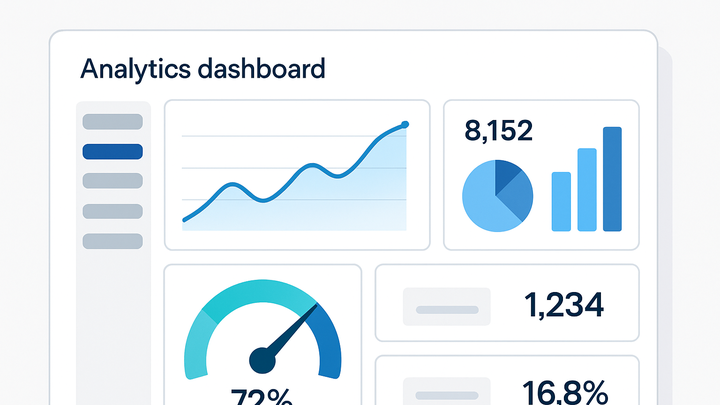Published on 2025-06-26T04:18:11Z
What are Key Performance Indicators (KPIs)? Analytics Definitions and Examples
Key Performance Indicators (KPIs) are quantifiable metrics used to evaluate the success of an organization, project, or specific activity in analytics. They provide a clear measure of performance relative to strategic objectives and help teams focus on what matters most. In digital analytics, KPIs might include metrics like conversion rate, bounce rate, or average session duration. By tracking KPIs with tools such as PlainSignal or Google Analytics 4 (GA4), businesses can monitor progress in real time and make data-driven decisions. Well-defined KPIs align with your business goals, are easy to understand, and can drive continuous improvement in marketing and product strategies. Selecting the right KPIs ensures that resources are allocated effectively and teams stay aligned on common objectives.
Key performance indicators (kpis)
Quantifiable metrics that measure progress toward strategic goals in analytics.
Understanding KPIs in Analytics
An overview of what KPIs are and their role in data-driven strategies.
-
Definition and purpose
KPIs are measurable values that reflect how effectively an organization or team is achieving key business objectives.
-
Types of kpis
KPIs can be categorized based on timing and scope, helping analysts select the most relevant indicators.
-
Leading indicators
Predict future performance by highlighting trends before they occur.
-
Lagging indicators
Reflect outcomes after a process has completed, such as total revenue or end-of-month conversion rate.
-
Why KPIs Matter
KPIs translate abstract goals into concrete metrics, guiding decision-making and resource allocation.
-
Align goals and actions
By defining KPIs that tie directly to strategic objectives, teams can focus on high-impact activities.
-
Enable data-driven insights
Regularly monitoring KPIs uncovers performance gaps and opportunities for optimization.
Choosing Effective KPIs
Guidelines for selecting KPIs that are relevant, measurable, and actionable for your organization.
-
Apply the smart framework
Ensure each KPI is Specific, Measurable, Achievable, Relevant, and Time-bound.
-
Specific
Clearly define what is being measured and why it matters.
-
Measurable
Choose metrics that can be tracked accurately over time.
-
Achievable
Set realistic targets that motivate teams without overpromising.
-
Relevant
Focus on indicators that directly impact your business objectives.
-
Time-bound
Assign a timeframe to assess progress and drive urgency.
-
-
Balance high-level and detailed metrics
Combine macro KPIs like revenue growth with micro KPIs such as click-through rate to get a full performance view.
Examples of KPIs in PlainSignal and GA4
Real-world KPI examples using PlainSignal (cookie-free analytics) and Google Analytics 4.
-
PlainSignal kpis
With PlainSignal, you can track session count, unique visitors, and average engagement time without relying on cookies.
-
Sessions
Total number of user sessions recorded.
-
Unique visitors
Count of distinct users interacting with the site.
-
Engagement time
Average duration users spend actively engaging with content.
-
-
GA4 kpis
GA4 supports advanced KPIs such as conversion events, user retention, and monetization metrics.
-
Conversion rate
Percentage of sessions that resulted in a defined conversion event.
-
Retention rate
Proportion of users returning to the site after the initial session.
-
Revenue per user
Average revenue generated per user in e-commerce setups.
-
Implementing KPI Tracking
Step-by-step guide to set up KPI tracking with PlainSignal and GA4.
-
Embedding PlainSignal code
Embed the PlainSignal snippet in your site’s <head> to start capturing data:
<link rel="preconnect" href="//eu.plainsignal.com/" crossorigin /> <script defer data-do="yourwebsitedomain.com" data-id="0GQV1xmtzQQ" data-api="//eu.plainsignal.com" src="//cdn.plainsignal.com/plainsignal-min.js"></script> -
Configuring kpis in GA4
In GA4, define conversion events in Admin > Events, then mark key actions as conversions to start tracking your KPIs.
Best Practices and Common Pitfalls
Tips to optimize KPI usage and avoid misinterpretation.
-
Regular review and adjustment
Revisit KPIs periodically to ensure they remain aligned with evolving business goals.
-
Avoid vanity metrics
Focus on metrics that drive meaningful insights rather than superficial numbers like total pageviews.
